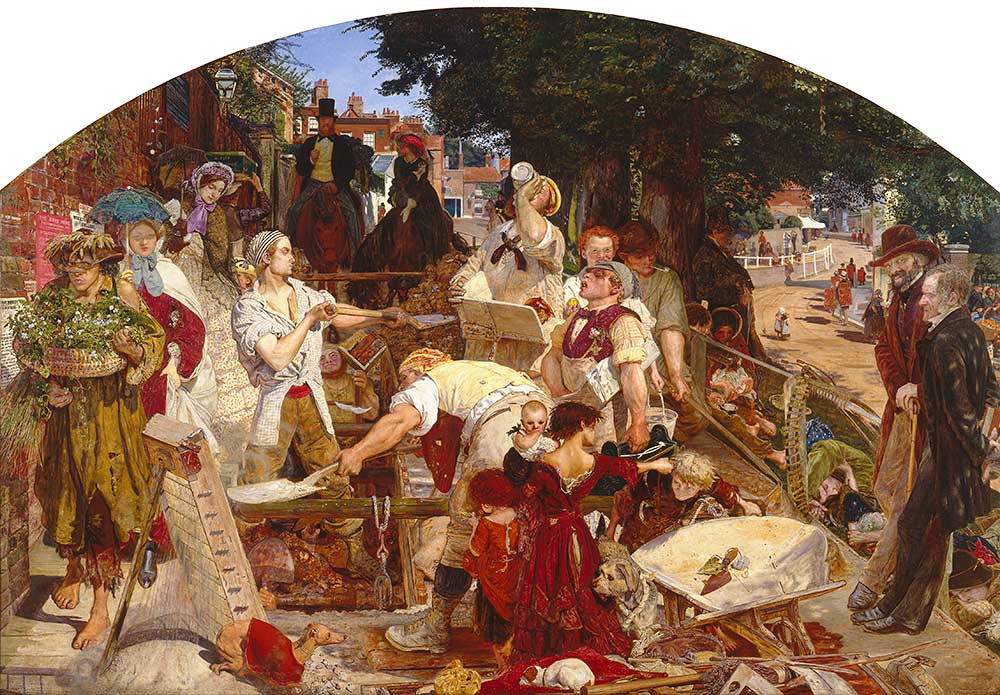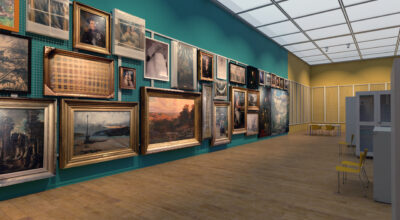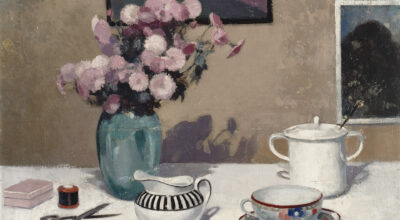Since the arrival of the Coronavirus pandemic, our team of guides have been unable to deliver live tours in the Gallery, due to lockdown closures and the need for social distancing. We now offer virtual tours once a fortnight over Zoom in the MAG Unlocked programme. We have chosen Ford Madox Brown’s painting ‘Work’ on a number of occasions and focussed on different aspects of the painting. Here each guide talks about their interest in the painting.
Unlocking ‘Work’ by Ford Madox Brown

CHILDREN IN ART
Work is about the different social classes and the work and lifestyle available to them. In the mid 1850s, half of Britain’s population was under 20 and Ford Madox Brown has reflected this by including 2 babies and 9 children.
Brown has used children to add to his description of Victorian society and his observations on it. The type of work that Brown has enabled involves bringing fresh water to the community. There’d been a cholera epidemic in 1854, because of water pollution and lack of sanitation. 10,000 Londoners died, including one of Brown’s servant girls.
Let’s have a look at the children.

The group of motherless street urchins was described by Madox Brown as “Ragged dirty brats, who get in the way and make a noise.” They do have an endearing side – “they like insects and miniature plants.” They are neglected by their drunken father and he will be prosecuted for this. They’re at the bottom of the painting and the bottom of the social order.
The eldest child is no more than 10 and wearing a woman’s dress, which has been donated to her. It’s FAR too big. She hasn’t the means or ability to alter the dress. Her work is the role of mother and the two younger children cling to her. She tries her best to keep her little brother in check and Brown says this is causing her prematurely to be “a SCOLD.” Her little sister is eating a carrot. The poor didn’t have the problem of excessive sugar consumption affecting the rich at that time.
But to many Victorians, DRUNKENNESS was the cause of society’s ills. Many well to do, well dressed ladies, such as the one with the purple bonnet to the left of the road workers, would distribute temperance tracts and they focussed on working class men. She’s just directed one of her tracts into the trench. You can see that the navvies are disregarding the tract fluttering in their midst and there’s a screwed up tract in the wheelbarrow. The lady’s little girl is clinging to her – a little bit like the little girl snuggling towards her big sister in the group of urchins. But their lives are worlds apart.
There’s another family group underneath the tree – a young, shoeless Irish man with his wife and child – victims of the Great Famine. I think Brown is being particularly sympathetic here. The young woman’s bonnet looks like a halo, reminiscent of a mother and child or Holy Family depiction. Look at the way they are tending their child – the husband carefully spoon-feeding gruel and his wife carefully holding the baby.
Not far away, two little girls are carrying jugs, illustrating how conditions were at the time regarding water supply. They would have to walk long distances to and from a standpipe or pump and they would have to queue.
But, despite poverty and hardship, children will be children. Three children are playing on the railings. They’re barefoot and you can see that the child on the left somersaulting over the railing has no underclothes, such is their deprivation.
Ann Jackson, Volunteer Guide at Manchester Art Gallery
IN FASHION
I chose “Work” for my tour “In Fashion”, as it’s a great example in showing the fashions of the mid 1850s and the contrasts between rich and poor. At this time, people had very few clothes and these were mainly all hand-made, so only the rich would be able to afford the expense of tailored garments. Clothes were rarely thrown away, but would be passed on, sold on, recycled and adapted.

There are some very fine outfits in the painting – we see the MP and his daughter returning from Hampstead Heath in their splendid riding costumes, only to find that their path is symbolically blocked by the road workers. On the left, we see two very elegant ladies squeezing through a narrow space by the workers. It’s a hot day, but the ladies are wearing voluminous and cumbersome skirts, cape jackets, shawls, leather boots, gloves and tightly fitted bonnets, one of them shielding herself from the sun with a parasol. As a total contrast, just in front of them, we see the chickweed seller in tattered rags, a hole in the brim of his hat and he is barefoot.
The depiction of the workers at the centre of the painting gives a fascinating insight into working clothes of the day – bandanas, shirts with rolled up sleeves, hard-wearing trousers and sturdy boots. By now, the sewing machine, first invented in 1830, is becoming more widely used which means that clothes could now be made more quickly and more cheaply thus meeting the demand for sturdy workwear to clothe the expanding populations in cities like Manchester.
At the bottom of the painting, we see a young girl holding a baby and caring for her brother and sister. The black ribbon on the baby’s sleeve tells us that there has been a death – most likely the mother of this little family. The girl’s red dress – once a fine garment that has probably been handed down many times – is too big for her but a pin at the back of her dress helps with the fit- see if you can spot it in the painting next time you visit the Gallery!
On the far right, we see two gentlemen – Thomas Carlyle and Reverend Maurice, who are soberly dressed and look very slim compared to the ample figures of the two elegant ladies. There is even a hierarchical dress code for the dogs that you see at the bottom of the painting – the dog belonging to one of the elegant ladies wears a smart red coat and a silver collar, whereas the dog on the right belonging to the lower classes just has a rough piece of rope for his lead.
There was very little photography at this time, so how fortunate that Ford Madox Brown completed this masterpiece in such amazing detail to show not only the fashions of the time but many other aspects of everyday life in Victorian society.
Isabelle Killicoat, Volunteer Guide at Manchester Art Gallery.
SOCIAL CLASS IN VICTORIAN ART
I used ‘Work’ by Ford Maddox Brown to explore the Victorians’ obsession with social class and placing people in particular social categories. We see the rapid growth of cities together with the economy and a wealthy middle class emerging during this time where improvement was part of their culture. The rise of this wealthy middle class changed the art market with a new class of rich businessmen willing to spend their money on paintings.
In contrast, the working class/lower working class worked in brutal and unsanitary conditions – they did not have access to clean water and food, education for their children or proper clothing. Artists, instead of recoiling from urban reality, began to celebrate it with street scenes, the nobleness of work, railway stations, seaside and even crime all provided subjects for painting.

Although Brown was never himself an official member of the Pre Raphaelite Brotherhood, he did adopt many of their stylistic tendencies, particularly the use of bright colours and attention to detail. Brown got the idea for ‘Work’ from seeing navvies excavating sewers in Hampstead, North London – it is typically assumed that this was part of the extensions of London’s sewerage system, which were being undertaken to deal with the threat of typhus and cholera. With the hard-working navvies central to the painting, Brown uses a hierarchical composition to illustrate the different social classes – in contrast to the navvies, and depicting the lower class, the ragged and barefoot plant seller is described by Brown as a “ragged wretch who has never been taught to work”.
Then there is a group of ragged children, whose mother is dead and the oldest girl of ten is in charge of the rest of the children. In contrast, middle class ladies represent philanthropic acts and religious education. Brown also includes two prominent men of the day, Frederick Denison Maurice and Thomas Carlyle which give emphasis to the importance of education and self-improvement.
Finally, overlooking the street scene on horseback, we have an upper class couple on horseback, who by virtue of their wealth and place in society, have no need to work.
So I chose ‘Work’ because it is an excellent illustration of social stratification in Victorian England providing a commentary on the role of work and its relationship to Victorian class structure. It is also a stunning example of the Pre Raphaelite style of painting.
Nina Wainwright, Volunteer Guide at Manchester Art Gallery
(DON’T) VOTE FOR BOBUS
Upon first viewing, one can quite easily feel overwhelmed by this epic sweep of mid Victorian society. A vast teeming humanity seems to tumble out of the canvass as though from a lucid dream, but we can readily find guides in the two prominent figures to the right; Christian Socialist Frederick Maurice and controversial historian, Thomas Carlyle. They are joined in momentary admiration for the swirl of human energy dominating the centre. There, the labourers appear transcendental as they heroically devote their evident physical strength to a water-engineering project that will improve the wellbeing of everyone.

Careful scrutiny reveals a further reference to Frederick Maurice on the red brick wall to the far left. Amongst the cluster of posters is one bearing the title ‘Working Men’s College’; the institution that he had helped to found in London during 1854. Education and hard work would therefore be the key to personal fulfilment.
A recurring theme in Thomas Carlyle’s books was the importance of true heroism and moral leadership down the centuries. But it was through the writing of such history that he realised just how debased the values of his own day had become. Industrialisation he believed, had allowed the relentless pursuit of profit to come to the fore. Where once the human spirit had flourished, there now seemed only to be avarice. The torn fragment of a poster, again on the red wall, ironically proclaims ‘Money!! Money!! Money!!’
Bobus Higgins is a fictional character from Carlyle’s ‘Past and Present’ (1843) and is the very embodiment of everything that the author deplores. In his prolific and exploitational business practice, Bobus displays a complete ignorance of the individual talent and potential that a person can bring to the world. A later Carlyle work reveals that his villain is in fact a corrupt sausage manufacturer who readily finds a use for horse meat! The sandwich boards being carried along the street to the right, reveal that an election is taking place and that people are being exhorted to ‘Vote for Bobus’. A notice affixed to the fence tells us that depressingly, he will win but just beyond the procession, we notice an emerging horse drawn carriage. The uncontrolled dog in the middle of the road seems poised to worry the horses and we are invited to imagine ensuing chaos of the sort witnessed in Hogarth’s ‘Chairing the Member’ from ‘The Humours of an Election’ series of 1755:
In ‘Work’, Ford Madox Brown portrays a world still very much at odds with itself, but in so doing, he provides reassuring glimpses of the human capacity to care. A final visit to the red wall discovers the besmirched remains of one more Bobus poster. Scrawled on to it is the word ‘Don’t’. In spite of everything, there may yet be grounds for hope!
John Ward, Volunteer Guide at Manchester Art Gallery
MAG Unlocked Zoom tours are continuing into 2021. Find out more on our events page



